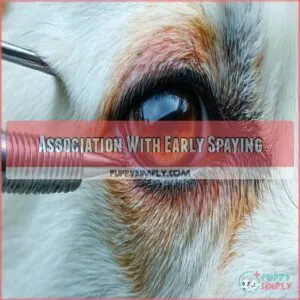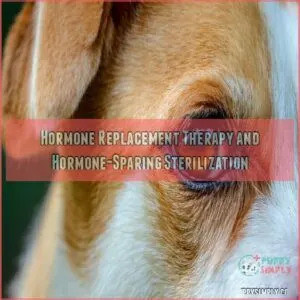This site is supported by our readers. We may earn a commission, at no cost to you, if you purchase through links.
 Experiencing strange behavior after spaying is totally normal for your furry friend.
Experiencing strange behavior after spaying is totally normal for your furry friend.
Your pet might feel like she’s on an emotional roller coaster due to hormonal changes and post-surgery discomfort. You’ll likely notice increased clinginess, mood swings, or even temporary anxiety. She might seem less energetic, act more irritable, or have changes in appetite.
Don’t panic—these shifts are part of her healing process. Keep her environment calm, provide gentle care, and monitor any extreme behaviors.
While most changes are temporary, persistent aggression or unusual symptoms warrant a quick chat with your vet.
Wondering what other surprising post-spay transformations might be coming your way?
Table Of Contents
- Key Takeaways
- Understanding Strange Behavior After Spaying
- Behavioral Effects of Spaying on Female Dogs
- Puberty and Behavior in Dogs
- Case Study: Daisy’s Post-Spaying Behavior
- Helping Your Dog After Spaying
- Frequently Asked Questions (FAQs)
- Why does my dog have strange behavior after spaying?
- Does spay/neuter cause behavior changes in dogs?
- Does a spayed dog act weird after being spayed?
- How does a female dog behave after spaying?
- Does Spaying a dog affect behavior after surgery?
- What happens after a dog is spayed?
- Does a female dog’s behavior change after spaying?
- How do you know if something is wrong after spaying?
- What is false season in dogs after spaying?
- How long does it take for a dog to act normal after being spayed?
- Conclusion
Key Takeaways
- You’ll likely see temporary behavioral changes after your dog’s spay surgery, including mood swings, lethargy, and shifts in energy levels, which are completely normal parts of her recovery journey.
- Hormonal disruptions can trigger unexpected reactions like increased anxiety, reduced obedience, and potential aggression, so you’ll need to provide extra patience and gentle care during her healing process.
- Your dog’s behavior typically stabilizes within 10-14 days post-surgery, but each pup’s recovery is unique, so you’ll want to monitor her closely and create a calm, supportive environment.
- While most behavior changes are temporary, you should watch for persistently unusual symptoms and consult your veterinarian if you’re concerned about extreme or long-lasting behavioral shifts after spaying.
Understanding Strange Behavior After Spaying
You might notice your furry friend acting a bit off after her spay surgery, and that’s totally normal for many dogs.
Her strange behavior—from mood swings to energy dips—stems from hormonal changes and the physical recovery process, so don’t panic and give her some extra TLC during this time.
Hormonal Changes and Recovery Period
After spaying, your furry friend will go through a hormonal rollercoaster that can leave her feeling like a different dog.
Hormonal fluctuations can trigger unexpected behavior changes, turning your normally calm pup into a bundle of nerves or occasional grumpiness.
Pain management and careful monitoring are essential.
You’ll need to be patient during this recovery period, understanding that her body is adjusting to significant internal changes.
Expect potential shifts in sleep patterns and activity levels as her body heals.
With gentle care and understanding, you’ll help her navigate this challenging adjustment smoothly.
Temporary Behavior Changes During Recovery
Managing post-spay recovery can feel like walking a tightrope with your furry friend.
Your pup might show unusual behavior as she heals, including post-op lethargy, anxiety spikes, and mood swings triggered by pain and disorientation. Expect some restlessness and irritability as her body adjusts to the surgical changes.
Appetite changes are common, with some dogs becoming picky eaters or showing reduced food interest due to medication.
To prevent post-operative complications, make certain your dog wears a post spay cone as directed by your veterinarian.
Your dog’s spay recovery symptoms might include increased clinginess or temporary sensitivity.
Stay patient and create a calm environment that supports her wound healing. Gentle care, minimal stress, and close monitoring will help her move smoothly through this challenging recovery period.
Rare Extreme Behavior Changes
While your pup’s recovery might seem smooth, some dogs experience rare extreme behavior changes that can catch you off guard. These unusual behaviors aren’t just a quirk – they’re signals your furry friend needs extra support.
Watch out for potential red flags:
- Extreme aggression without provocation
- Sudden fear of familiar people or spaces
- Incessant vocalization or whining
- Self-mutilation behaviors
- Unexplained paralysis or severe lethargy
When strange behaviors emerge after spaying, don’t panic. Your veterinarian is your best ally in understanding these rare reactions. Behavioral therapy and careful monitoring can help your dog navigate these unexpected changes. Each pup responds differently to surgery, so patience and professional guidance are key to helping your four-legged friend bounce back to their normal, loving self.
Behavioral Effects of Spaying on Female Dogs
If you’re noticing changes in your female dog’s behavior after spaying, you’re not alone in wondering what’s normal and what’s cause for concern.
Recent studies suggest that spaying can trigger unexpected shifts in your pup’s temperament.
These shifts range from increased anxiety to potential aggression, especially when performed during early developmental stages.
Increased Aggression, Fearfulness, and Anxiety
Spaying can throw your dog’s emotional world for a loop, sparking unexpected aggression, fear, and anxiety.
These behavioral shifts stem from hormone removal during surgery, turning your typically calm pup into a more reactive companion.
Watch for aggression triggers like sudden movements or loud noises that might set her on edge.
Combat post-spay anxiety by creating a zen-like environment with predictable routines and gentle interactions. Positive reinforcement becomes your secret weapon – reward calm behaviors and provide plenty of reassuring cuddles.
If her anxiety seems overwhelming, an animal behavior specialist can help navigate these choppy emotional waters. Remember, patience is your best friend during this hormonal rollercoaster.
Association With Early Spaying
Dig deeper into the hidden risks of early spaying, and you’ll uncover a complex landscape of potential behavioral shifts in female dogs.
Research reveals three critical insights about early spaying:
- Hormone disruptions during puberty can trigger unexpected personality changes
- Surgical timing has a substantial impact on long-term behavioral outcomes
- Adolescent dogs may experience increased anxiety and aggression
The ripple effects of early spaying extend beyond the operating table, potentially reshaping your furry friend’s temperament.
Canines can exhibit flexible sexuality, which may be influenced by factors such as social benefits.
Your proactive approach can help mitigate potential behavioral issues, ensuring your pup maintains a balanced, confident personality throughout her developmental journey.
Hormone Replacement Therapy and Hormone-Sparing Sterilization
Worried about your dog’s behavior after spaying? You’re not alone.
The good news is that hormone replacement therapy (HRT) and hormone-sparing sterilization offer promising alternatives to traditional spaying. These methods can help minimize hormonal disruptions and potential behavioral side effects.
| Option | Pros | Cons |
|---|---|---|
| HRT | Maintains hormone balance | Requires ongoing management |
| Tubal Ligation | Prevents pregnancy | Doesn’t stop heat cycles |
| Ovary-Sparing Spay | Preserves some hormones | More complex procedure |
| Traditional Spay | Most common method | Potential behavioral changes |
Each approach has its unique benefits. Some veterinarians now recommend these alternative sterilization methods to reduce the risk of long-term behavioral changes.
Your furry friend’s well-being matters most, so chat with your vet about the best path forward.
Puberty and Behavior in Dogs
If you’ve noticed your dog’s behavior changing during puberty, you’re not alone.
Understanding these temporary shifts can help you navigate this tricky phase.
what’s happening after her spay surgery?
patience and support for your furry friend.
Temporary Reduction in Obedience
After riding the rollercoaster of early behavioral changes, you’ll likely hit another bump: the obedience lapse.
Your once-perfect pup might suddenly seem to have forgotten every command you’ve ever taught. This post-op defiance isn’t rebellion – it’s a natural part of your dog’s adolescent journey.
Your furry friend isn’t trying to drive you crazy; hormonal shifts and recovery are throwing a wrench in their usual compliance.
Training during this time requires extra patience and creativity. Use shorter, more frequent training sessions with high-value treats. Keep expectations realistic and celebrate small victories.
This post-operative disobedience is just a phase – your well-behaved companion will return, stronger and more bonded than ever.
Normalization of Behavior by 12 Months
As your furry friend navigates the rollercoaster of puberty, her behavior will gradually stabilize by the 12-month mark.
The post-spay journey isn’t always smooth, but understanding what to expect can help you stay calm.
Here’s what typically happens:
- Hormonal fluctuations begin to settle
- Obedience levels start returning to normal
- Individual behavioral patterns become more consistent
Your pup’s unique personality will shine through as her body adjusts. While some dogs bounce back quickly, others might need more time.
Veterinary advice becomes your compass during this period, helping you distinguish between normal recovery and potential concerns. Remember, patience is your superpower. Each dog’s recovery timeline differs, so don’t panic if your furry friend seems a bit off-kilter. With love and understanding, you’ll both navigate this chapter successfully.
Managing Behavior Changes With Patience
Ready to help your pup bounce back from spay surgery? Shifting from recovery to behavioral management requires a gentle touch.
Your dog might test your patience with newfound moodiness, but stay calm and consistent. Focus on reward-based training that celebrates good behavior instead of punishing mishaps.
Offering the right recovery toys and aids can also make a big difference in their healing process. Offer mental stimulation through puzzle toys, which can distract from post-spay discomfort and boredom.
Medication and emotional support are your secret weapons in managing potential separation anxiety or pain.
Remember, those behavioral hiccups are temporary – your furry friend will soon return to their lovable self. Patience isn’t just a virtue; it’s your roadmap to helping your dog heal and thrive.
Case Study: Daisy’s Post-Spaying Behavior
If you’ve noticed your furry friend acting differently after her spay surgery, you’re not alone in wondering what’s normal.
Daisy’s case study reveals the unexpected behavioral changes.
that can catch even seasoned pet owners by surprise, offering insights into the recovery journey that might just help you navigate this challenging time.
Concerns and Observations After Surgery
Dog-mom detective mode: your post-spay patient requires hawk-eyed monitoring for subtle behavior changes.
Unusual symptoms like reduced appetite or persistent whining could signal post-op discomfort. Watch for signs of pain that might trigger post-spay anxiety or aggression.
Your pup’s emotional landscape might feel like a rollercoaster during wound healing, so patience is your secret weapon.
Comfort is key – create a calm environment that helps her feel secure. Keep feeding times consistent, even if she’s not enthusiastic about meals. Soft bedding, gentle touches, and a quiet space can make a world of difference in her recovery journey.
Recovery and Activity Restrictions
Managing post-spay recovery requires careful management of your dog’s activity levels. For the first 10 days, stick to leash walks only and limit her movement to prevent strain on the surgical site.
Think of this period as a vital healing window where rest becomes your best friend.
Veterinarians recommend a strict 14-day activity restriction to support complete wound healing and minimize potential complications.
Keep her in a calm, controlled environment, using baby gates or a comfortable crate if needed. Avoid rough play, jumping, or any strenuous activities that could reopen the incision or cause pain.
Gentle supervision and patience will help your furry friend sail through recovery smoothly, ensuring her body has the best chance to heal completely and comfortably.
Addressing Changes in Eating Behavior and Whining
After carefully restricting her activity during recovery, you’ll likely notice Daisy’s eating habits and whining might seem a bit off-kilter. Don’t panic—this is totally normal.
Puzzle toys can be your secret weapon for managing post-spay anxiety and whining. Try leaving food out for 20 minutes, then removing it to help regulate her appetite without overwhelming her healing body.
Short, gentle leash walks can provide mental stimulation while keeping her calm.
Soft, reassuring touches and a quiet environment will help her feel secure.
Remember, her body’s adjusting to significant hormonal changes, so patience is your best friend. These behavior shifts are temporary, and with gentle support, she’ll be back to her playful self soon.
Helping Your Dog After Spaying
After your dog’s spay surgery, you’ll likely notice some unusual behaviors.
These changes might catch you off guard.
Understanding these changes and knowing how to support your furry friend can help make her recovery smoother.
her recovery will also be less stressful for both of you.
Understanding Short-Term and Long-Term Behavior Changes
Brace yourself for a rollercoaster of behavioral changes after your dog’s spay surgery. The long-term and short-term effects can feel like walking through an emotional minefield, but understanding these shifts is your secret weapon.
Post-surgery lethargy might knock your pup’s energy down, while hormone fluctuations could spark unexpected anxiety or mood swings.
Your furry friend might seem like a different dog altogether – more skittish, potentially more aggressive, or just plain confused. These behavioral changes are normal, stemming from the massive hormonal reset her body is experiencing.
Pain management, gentle support, and a keen eye can help her navigate this recovery period. Stay patient, keep communication open with your vet, and remember: this too shall pass.
Providing Support and Patience During Recovery
Sometimes the key to helping your dog recover smoothly after spaying is mastering the art of patience and strategic support.
Your furry friend needs gentle care during post-op recovery, which means strictly controlling activity levels and monitoring her closely.
Keep her on short, controlled leash walks to prevent stitch damage and reduce movement stress. Offer small, frequent meals and remove uneaten food after 20 minutes to encourage eating without overwhelming her.
Keep in mind that safe lifting techniques can greatly reduce stress and discomfort during this period.
If unusual behaviors persist, don’t hesitate to consult your veterinarian for personalized guidance on managing her post-spay healing journey.
Exploring Natural Supplements for Calming Effects
Your post-spay pup’s anxiety remedy might just be hiding in nature’s medicine cabinet. Natural supplements can be powerful allies in soothing your furry friend’s recovery nerves.
- Chamomile‘s gentle touch soothes jangled nerves
- Hemp oil whispers comfort to stressed canines
- Valerian root eases surgical stress naturally
- Amino acids restore emotional balance gently
When exploring anxiety relief for your spayed dog, focus on holistic approaches that support healing without harsh chemicals. CBD oil and adaptogens can help regulate your pet’s emotional landscape, providing a natural buffer against post-surgical stress. Remember, each dog responds differently, so start with small doses and monitor your pup’s reaction carefully. Your veterinarian can offer personalized guidance on choosing the right supplement for your furry friend’s unique needs.
Frequently Asked Questions (FAQs)
Why does my dog have strange behavior after spaying?
Hormone shifts trigger your dog’s post-spay roller coaster ride.
Surgical stress, pain, and anesthesia can cause temporary disorientation, anxiety, and mood swings.
Be patient, provide gentle care, and consult your vet if concerns persist.
Does spay/neuter cause behavior changes in dogs?
Spaying can trigger significant behavioral shifts in dogs, including increased anxiety, aggression, and mood changes.
Research suggests these transformations stem from hormonal disruptions, potentially affecting your pet’s temperament and emotional stability long-term.
Does a spayed dog act weird after being spayed?
Peculiar pups post-surgery might seem spacey and slow.
You’ll likely notice lethargy, disorientation, and mild mood shifts as she recovers.
Don’t panic—these temporary changes are normal and typically resolve within a few days to weeks.
How does a female dog behave after spaying?
After spaying, you’ll likely notice your dog feeling tired, a bit clingy, and less energetic.
She might seem confused or moody as her body adjusts to hormonal changes.
Patience and gentle care will help her recover smoothly.
Does Spaying a dog affect behavior after surgery?
You’ll likely notice your dog’s behavior shifting after surgery.
Expect temporary lethargy, potential mood changes, and increased anxiety.
Patience and gentle care help your furry friend navigate this healing period smoothly.
What happens after a dog is spayed?
Imagine your pup emerging from surgery with a new lease on life.
She’ll likely feel groggy, need extra cuddles, and experience temporary behavioral shifts.
as her body adjusts to hormonal changes and healing.
Does a female dog’s behavior change after spaying?
When your female dog gets spayed, expect some behavioral shifts.
She might become calmer, less moody, and more relaxed.
However, hormonal changes can also trigger temporary anxiety, increased sensitivity, and potential personality adjustments during recovery.
How do you know if something is wrong after spaying?
Max’s dog suddenly stopped eating after surgery, signaling trouble.
Watch for persistent lethargy, appetite loss, infection signs, or unusual behavior lasting more than 24 hours.
If something feels off, trust your gut and contact your vet immediately.
What is false season in dogs after spaying?
You might experience a false season after spaying, where hormonal remnants trigger pseudo-pregnancy symptoms like swollen nipples, mild behavioral changes, and occasional milk production without actual pregnancy occurring.
How long does it take for a dog to act normal after being spayed?
Post-surgery blues can throw your pup’s rhythm off-track.
Most dogs bounce back to their normal self within 10-14 days, but patience is key.
Individual recovery varies, so watch for signs of healing and comfort.
Conclusion
Ultimately, strange behavior after spay is a natural journey for your furry friend.
While hormonal shifts and recovery can feel overwhelming, remember that patience and understanding are your best tools.
Stay vigilant, offer gentle support, and trust the healing process.
With time, your dog’s behavior will stabilize. Don’t hesitate to consult your vet if concerns persist, and remember that every dog’s post-spay experience is unique. This is a natural journey.















